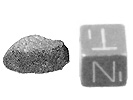
| MetSoc Home Publications Contacts |
 |
||
|
||
| Queen Alexandra Range 99517 | |||||||||||||||||||||
|---|---|---|---|---|---|---|---|---|---|---|---|---|---|---|---|---|---|---|---|---|---|
| Basic information | Name: Queen Alexandra Range 99517 This is an OFFICIAL meteorite name. Abbreviation: QUE 99517 Observed fall: No Year found: 1999 Country: Antarctica [Collected by US Antarctic Search for Meteorites program (ANSMET)] Mass:  1.4 g 1.4 g | ||||||||||||||||||||
| Classification history: |
This is 1 of 52 approved meteorites classified as L3.4. [show all] Search for other: L chondrites, L chondrites (type 3), Ordinary chondrites, and Ordinary chondrites (type 3) | ||||||||||||||||||||
| Comments: | Field number: 12525 | ||||||||||||||||||||
Writeup |
Writeup from AMN 25(1):

Macroscopic Description: Cecilia Satterwhite
Thin Section (, 2; ,4) Description: Linda Welzenbach, Gretchen Benedix, and Tim McCoy
| ||||||||||||||||||||
| Data from: MB86 Table A1 Line 476: |
|
||||||||||||||||||||
| Catalogs: |
| ||||||||||||||||||||
| References: | Published in Antarctic Meteorite Newsletter 25(1) (2002), JSC, Houston Published in Meteoritical Bulletin, no. 86, MAPS 37, A157-A184 (2002)
| ||||||||||||||||||||
| Photos: |
| ||||||||||||||||||||
| Geography: |
Statistics: This is 1 of 44543 approved meteorites from Antarctica (plus 3802 unapproved names) | ||||||||||||||||||||
| Proximity search: | |||||||||||||||||||||
| Also see: |
This lists the most popular meteorites among people who looked up this meteorite.
| ||||||||||||||||||||
| Revision history: |
This lists important revisions made to data for this record.
| ||||||||||||||||||||